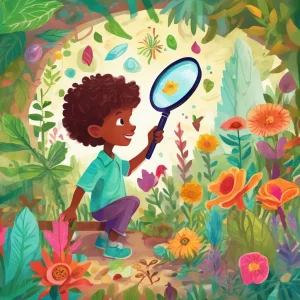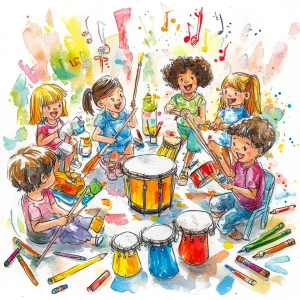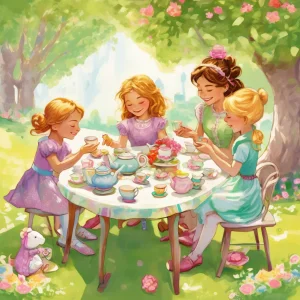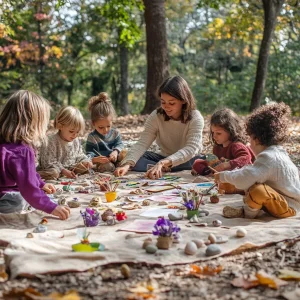Activity
Similar Activities
Enchanted Nature Quest: The Sensory Nature Hunt
Children’s Age: 0 month – 6 years
Activity Duration: 10 minutes
Let's go on a Sensory Nature Hunt! We will use our senses to find items like pinecones, leaves, rocks, and flowers. You can bring a basket, a list of things to find, and maybe a ma…
Activity Duration: 10 minutes
Empathy Through Storytelling: Musical Sensory Experience
Children’s Age: 2–3 years
Activity Duration: 5 – 15 minutes
Let's dive into Musical Sensory Storytime! Get ready for a fun experience that will engage all your senses. We will read a story, play musical instruments, create art, and enjoy co…
Activity Duration: 5 – 15 minutes
Holiday Textures Sensory Exploration for Infants
Children’s Age: 0 – 3 months
Activity Duration: 5 minutes
Engage infants aged 0 to 3 months in sensory play with this holiday textures exploration activity. Use soft fabrics, textured toys, and optional holiday-scented items in a quiet, s…
Activity Duration: 5 minutes
Sensory Treasure Basket Exploration: Infant's Discovery Journey
Children’s Age: 3 – 6 months
Activity Duration: 10 minutes
Engage your 3 to 6-month-old baby in the Sensory Treasure Basket Exploration activity to boost their sensory development and curiosity. Fill a basket with soft fabric pieces, teeth…
Activity Duration: 10 minutes
Enchanted Sensory Treasure Hunt for Toddlers
Children’s Age: 1.5–2 years
Activity Duration: 10 minutes
Engage toddlers aged 18 to 24 months in the Sensory Treasure Hunt for a stimulating sensory experience and physical development through movement and exploration. Gather textured it…
Activity Duration: 10 minutes
Adventure of Rhyme and Move Outdoor Magic
Children’s Age: 3–4 years
Activity Duration: 10 – 25 minutes
"Rhyme and Move Outdoor Adventure" is a fun activity that combines nature-themed rhymes with movement in an outdoor setting. Children get to explore the outdoors, practice language…
Activity Duration: 10 – 25 minutes
Enchanted Tea Party Adventure: A Magical Journey
Children’s Age: 3 years
Activity Duration: 10 – 15 minutes
Join us for a Magical Tea Party Adventure! Enhance your child's play skills, social-emotional growth, and language abilities through a whimsical tea party experience. Gather teacup…
Activity Duration: 10 – 15 minutes
Outdoor Tea Party and Fix-it Fun for Toddlers
Children’s Age: 2–4 years
Activity Duration: 10 – 25 minutes
Let's create a fun Outdoor Tea Party and Fix-it Station for kids aged 1 to 3. Set up a table and chairs, play tea set, pretend tools, household items for fixing, a picnic blanket, …
Activity Duration: 10 – 25 minutes
Sensory Bottle Exploration: A Magical Adventure
Children’s Age: 0 month – 6 years
Activity Duration: 10 minutes
Let's make a sensory bottle together! We will use a clear plastic bottle and fill it with water, oil, glitter, and colorful beads. The child can pour, mix, and seal the bottle to c…
Activity Duration: 10 minutes
Time Travel Artistic Adventure: A Historical Journey
Children’s Age: 3–9 years
Activity Duration: 10 minutes
Let's go on a Time Travelers Art Adventure! Kids aged 3-9 will love exploring different time periods through art. Get some paper, crayons, stickers, a timer, and a big space to cre…
Activity Duration: 10 minutes
Nature Explorers: Scavenger Hunt & Art
Children’s Age: 2–6 years
Activity Duration: 10 minutes
Let's go on a Nature Scavenger Hunt and Outdoor Art adventure! We will explore nature, collect items, and create beautiful artwork. You will need a bag, paper, crayons, watercolors…
Activity Duration: 10 minutes
Holiday Parade: Musical Social Skills Celebration
Children’s Age: 2–3 years
Activity Duration: 15 minutes
Get ready for the Holiday Music Parade! This fun activity is perfect for 2 to 3-year-old kids to enjoy music, march in a parade, and have a blast with holiday props. You'll need mu…
Activity Duration: 15 minutes



























